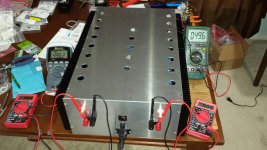Hello William2001,
how you determinate your value of R1 (none) and R2 (0.04ohm)?
Regards
Guglielmo
From the F6 article at firstwatt.com
"If you leave R13 at 0 ohms and put 0.05 ohms for R14, you will find yourself with a
positive-phase second harmonic. By this I mean there will be expansion as the wave goes
positive and compression as the wave goes negative."
I had some .08 ohm resistors in my stash, so I just stuck some in parallel.
I bought matched pairs from Teabag several years ago. If I remember correctly the SS parts have about half the distortion of the regular IRF parts. Allows more headroom for 2nd/3rd harmonic distortion profile adjustment preference. (I'm using the store boards with 0 ohms at R1, and .04 ohms at R2, cut trace from negative side of C2 and reconnected to -23V). And really nice that this thing is completely stable with very low/no source resistors. Really pleased with this configuration right now.
Are these the only changes needed to substitute SS R100's for IRFP240's?
Are these the only changes needed to substitute SS R100's for IRFP240's?
I changed R7 and R8 to 3K, replaced the zeners with green LED's (mouser p/n 604-WP2773GD), changed trimmers to 2K (mouser p/n 652-3296Y-1-202LF). At my bias current, I have 1.5V from g-s on Q1 and Q2. My gate stoppers (R11,R12) are 110 ohms. Not sure how critical the caps are but I chose to use Nichicon Muse (mouser p/n 647-UKZ1E102MHM).
I changed R7 and R8 to 3K, replaced the zeners with green LED's (mouser p/n 604-WP2773GD), changed trimmers to 2K (mouser p/n 652-3296Y-1-202LF). At my bias current, I have 1.5V from g-s on Q1 and Q2. My gate stoppers (R11,R12) are 110 ohms. Not sure how critical the caps are but I chose to use Nichicon Muse (mouser p/n 647-UKZ1E102MHM).
Thank you William!
So far so good.
The variac saved my butt, however, since I had set the pots in completely in the opposite direction. By 50v ac, bias was already reading .500 vdc.
As described in the build described here, go easy when adjusting the pots.
Thank!
Vince
The variac saved my butt, however, since I had set the pots in completely in the opposite direction. By 50v ac, bias was already reading .500 vdc.
As described in the build described here, go easy when adjusting the pots.
Thank!
Vince
Attachments
mhm, i really do have sonic problems with my F6. It sounds a bit boring, dull, dark, a bit next door. that quite differs to your descriptions 
maybe i had a mismatch of the transistors, and yes, i did the C-override mod and had the source resistors both 0.45 to cancel H2 the most.
I have an old Aleph J pcb here with Fairchild transistors (also 240N as far i know). Do you think i can try them in the F6 application?
regards,
st
maybe i had a mismatch of the transistors, and yes, i did the C-override mod and had the source resistors both 0.45 to cancel H2 the most.
I have an old Aleph J pcb here with Fairchild transistors (also 240N as far i know). Do you think i can try them in the F6 application?
regards,
st
i guess i´ll try the other transistors and try the H2 variation again, for now it sounds too next door with H2. But i´m quite shure it is just mine and not the circuit. I even beefed up the midragen about 6db. My amp seems to be good for Feastrex without correction
tnx,
st
tnx,
st
I have an old Aleph J pcb here with Fairchild transistors (also 240N as far i know). Do you think i can try them in the F6 application?
regards,
st
Yes.
What are you using now?
mhm, i really do have sonic problems with my F6. It sounds a bit boring, dull, dark, a bit next door. that quite differs to your descriptions
maybe i had a mismatch of the transistors, and yes, i did the C-override mod and had the source resistors both 0.45 to cancel H2 the most.
I have an old Aleph J pcb here with Fairchild transistors (also 240N as far i know). Do you think i can try them in the F6 application?
regards,
st
Mine is the complete opposite of what you are describing. Quick, detail revealing, attention getting sound is the way I would describe mine. Perfect for rock lovers or complicated orchestral pieces. My thoughts are something is not quite right with your amplifier. The F6 should not sound as you are describing it.
Yes.
What are you using now?
hi pico, it is also the 240 N but
just another brand (international R as far i know, i forgot, but i also just matched for Vth with a small chinese battery device). I guess i will swap them just for the fact that i´m curious.
But I also do have problems with the acoustics in the room/speakers, and so far it was a bit depression speaking yesterday and “accusing" the amp just a minor part of problem

back on the bench,
st.
- Home
- Amplifiers
- Pass Labs
- F6 Illustrated Build Guide
